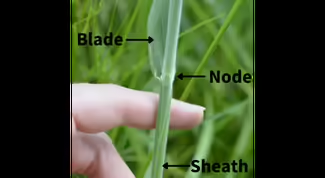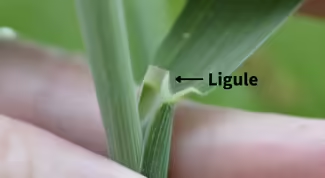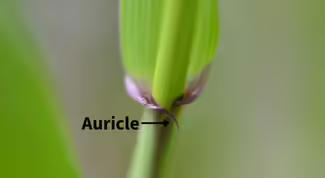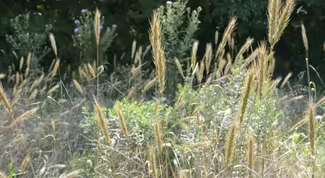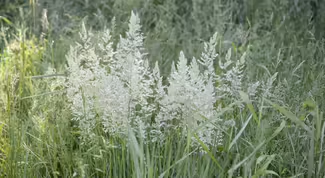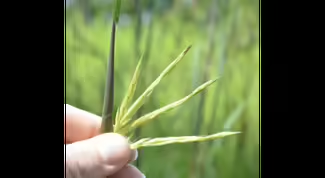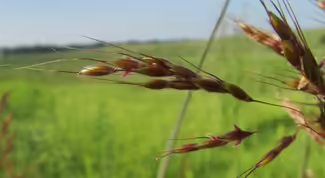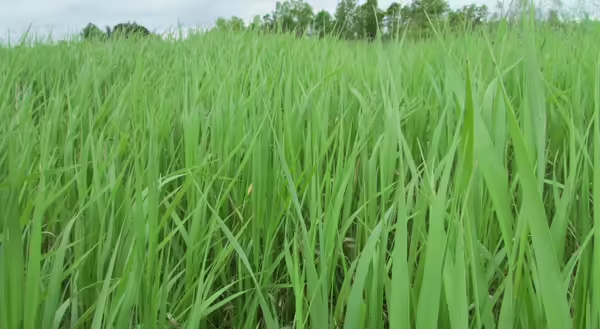
Spring is here and plants are greening up and leafing out almost 3 weeks ahead of schedule! My neighbors and I have already been out and about doing yard work and getting ready for the new season.
As we shake off the winter doldrums and welcome new spring life, it’s time to refresh your plant identification skills! I’ve already seen grasses in bloom (yes, you read that correctly!) so let’s go through a grass ID refresh so you can be prepared to get outside and tell which grass is which.
Where to begin
The first quick check that I do when I find a grass-like plant is to make sure it actually is a grass, and not a sedge, a closely related grass-like plant. One of the easiest ways to tell is to roll the stem between your fingers – if it is round, then it is likely a grass. If it is triangular, then it is a sedge. While these characteristics are general guidelines, there are exceptions.
Taking a close look at leaves
Grass leaves include a blade, which is the leafy portion; a sheath, which occurs when the base of the leaf blade wraps around the stem; and a node, which I like to think of as the kneecap of the grass. Nodes occur at the base of the leaf sheath and are swellings that look like joints. Rushes are another group of grass-like plants that have round stems, but they don’t have these nodes. A common rush in Illinois is the path rush, which grows within walking trails found in the woods.
Paying attention to the place where the leaf blade becomes the sheath, called the collar region, is important because there are diagnostic features here. The first is called a ligule, which is either a membrane or a ring of hairs that occurs in the space where the leaf blade becomes the sheath. Not all grasses have ligules, so the absence or presence of a ligule, as well as what type you see, are very helpful characteristics in grass identification. Membranous ligules look white early in the growing season, but turn yellow or brown later in the season, and they can be tall or short. Ligules can also be collections of hairs – which can be short and stiff or tall and silky. If a ligule is not present, look for an upside-down horseshoe-shaped smooth surface.
Some grasses have a structure called auricles, which are like little arms that extend from the base of the leaf blade and wrap around, or hug, the stem. If a grass has auricles, when you pull back the leaf blade you should see them unwrap and open.
Using spikelets, a grass's flowering structures
The flowering unit of a grass is called a spikelet. Grass spikelets, just like flowers, are held in arrangements called inflorescences. There are three main types of inflorescences: spikes, racemes, and panicles. You can differentiate the three using a few easy questions about if the main stem of the inflorescence branches and if the spikelets are held on little stalks.
Spikes are collections of spikelets that are directly attached to the stem. This means there is no branching. Examples of grasses with spike inflorescences include the ryes, barleys, and timothy.
Panicles have branches, and their spikelets can either be held on little stalks or be directly attached to the branches. The big difference here is that the main stem of a panicle branches. Look at Indiangrass, switchgrass, and Johnsongrass to find panicle inflorescences.
A raceme doesn’t have branching, but individuals spikelets, or a dense, finger-like collections of spikelets, are held on stalks. Look at little bluestem and broomsedge as well as big bluestem, gama grass, and side oats grama for examples of racemes. It takes some getting used to, but over time you will come to see the differences between these types of arrangements.
Another helpful characteristic on spikelets is the presence of awns and bristles. Bristles are found at the base of a spikelet, and often surround the spikelet like a bowl. They are most commonly found in foxtails. Awns look like bristles but extend from the tip of spikelets.
Need a little extra help with identification? Check out my series of 1-2 minute grass identification videos.
Thank you for reading!
Never miss a new post! Subscribe to our email list to get updates each time a new post is available.
Give us feedback! How helpful was this information (click one): Very helpful | Somewhat helpful | Not very helpful
ABOUT THE AUTHOR: Erin Garrett is a Natural Resources, Environment, and Energy Educator for University of Illinois Extension serving Alexander, Johnson, Massac, Pulaski, and Union counties. Erin develops and delivers high impact programming to adults and youth to help them develop an appreciation for natural resources and to empower them to make small changes to positively impact the environment. Erin’s programming focuses on why homeowners should consider choosing native plants, how to support native pollinators, how to identify grasses, how to identify and manage invasive species, and developing an appreciation for prairie ecosystems.
